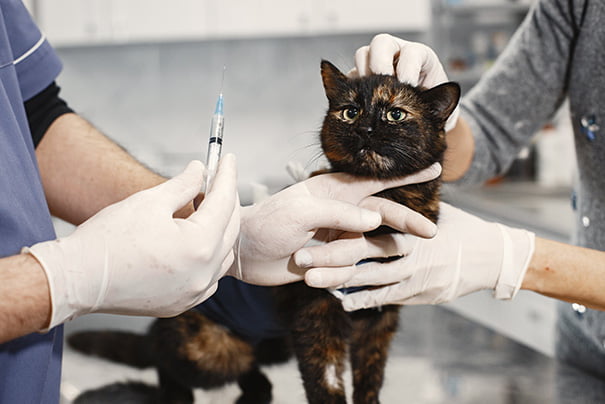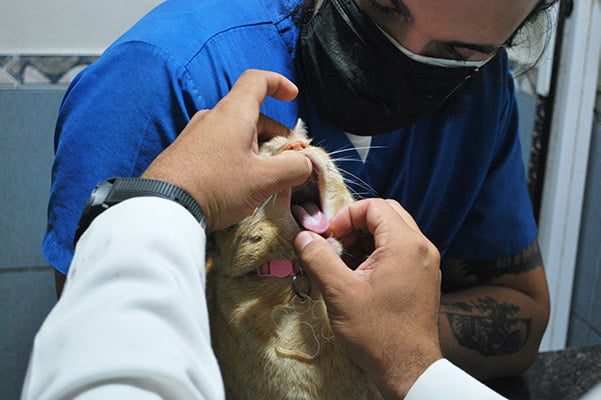Whether you just got a new kitten or adopted an adult cat from a shelter, you may be wondering how often you do you take a cat to the vet to ensure it stays healthy. The answer to that is it all depends on the cat's age and the general well-being of the cat you have.
Kittens have to go to the veterinary clinic a lot more often early on for all their vaccines and boosters, while full-grown cats only need to go once a year or so for an annual. So what are the exact expectations for each life stage? And what symptoms of illness indicate the need to visit the vet for more than just an annual check-up?
Vet Visits Based On Age
Kittens
When you adopt, rescue, or buy a new kitten, you should expect to be at the vet's every 3-4 weeks for a few months. The first few months of a kitten's life will be filled with a vet visit, as they need to be dewormed, tested, vaccinated, sprayed, and neutered, all before six months old.
Once a kitten is 6-8 weeks old, it must begin its first round of vaccines, including rhinotracheitis, calicivirus, panleukopenia, and the feline leukemia vaccine. 3-4 weeks later, they will need another round of those vaccines and should continue receiving them until the young kittens are four months old.
Rabies vaccines should start at three months, and your kitten should get a booster when it reaches a year old. The recurrence of boosters after that depends on the specific rabies vaccine but is often every three years. Deworming treatments will be given to your kitten at some early stage, during a vaccine visit, since most kittens get intestinal worms from their mother.
During these frequent visits, your vet will also conduct physical examinations of your kitten to ensure it grows and develops well. You can also begin to discuss tick and flea prevention options. At six months, your kitten can be spayed or neutered. Finding a cat collar for fleas prevention might be a good option as well.

Image Source: Prexels
Adult Cats
Healthy adult cats that are generally healthy only need to go to the vet annually. The annual check-up will also ensure your cat's teeth and gums are healthy. Depending on the cat's age and how well its teeth are cleaned, they may require dental cleanings. The best way to avoid paying the vet to clean your cat's teeth is to brush them regularly yourself with a cat toothbrush and toothpaste.
Vaccine boosters will continue to be applied throughout this stage as needed as well as any preventative care. One additional consideration you and your vet will need to work through will come as the result of whether your cat is an indoor or outdoor cat.
An adult cat who spends any time outdoors will be at risk for a great deal more illness and disease, and your vet may have recommendations for preventative ways to protect your cat from parasites, diseases, and predators. These annual exams will also ensure that any serious conditions can be caught early on and treated immediately.
Seniors
By the time your cat reacts 6-8 years old, it may be time to consider twice-annual vet visits. As a senior cat, your cat will be prone to more illness and health issues, and catching these conditions early is vital to prolonging your cat's life.
These trips should include a physical examination, and cat owners should bring up any changes in behavior or appearance so that you and your vet can avoid any serious issues. Senior cats with health issues may need to be seen even more often than every six months, but that is something pet owners can determine with their vets.
Common Illnesses In Cats
The other main reason that determines how often you bring your cat to the vet is whether or not it develops health concerns. Cats can get sick or hurt like any other animal and will need to be treated by veterinary experts.
Feline Lower Urinary Tract Disease
FLUTD is actually a group of diseases affecting your cat's digestive system and can be very serious, requiring immediate medical attention. Cats are at higher risk of deploying FLUTD if they are overweight, unfit, or only eat dry food. The diseases can also be triggered by sudden changes and stress in your cat's life. Symptoms of FLUTD include—
- Increased thirst
- Straining to urinate
- Bloody urine
- Crying when peeing
- Lethargy
- Dehydration
- Change in appetite
- Vomiting
Fleas
Fleas are relatively common and highly treatable, but if left untreated for too long can lead to anemia in adult cats. Flea infestations in very small kittens can be fatal. Symptoms of fleas include—
- Flea dirt
- Excessive scratching
- Excessive licking
- Irritated or infected skin
- Hair loss
Tapeworms
Tapeworms are intestinal parasites that live and grow in the small intestine and are often the result of a cat swallowing a flea. They are highly treatable, and symptoms include—
- Vomiting
- Weight loss
- White worms in feces (these will look like grains of rice or sesame seeds)
Eye Issues and Diseases
A few of the more common cat eye conditions include corneal ulcers, conjunctivitis, cataracts, glaucoma, eye trauma, and retinal disease. Common symptoms of eye issues include—
- Pawing at eyes
- Watery eyes
- Cloudy eyes
- Red or white eyelids
- Squinting
Feline Diabetes
Diabetes is unfortunately quite common in cats and often goes untreated. While it cannot be cured, diabetes can be controlled through a restrictive diet and insulin therapy. Symptoms of feline diabetes include—
- Increased urination
- Excessive thirst
- Weight loss
- Increased appetite
Physical Injury
Another reason to take your cat for a vet visit is for physical injuries such as deep cuts or lacerations, animal fights, possible broken bones, or major physical trauma.

Image Source: Pexels
Dental Disease
Dental disease is a common medical problem among older cats. The three common dental diseases in cats are gingivitis, periodontitis, and tooth resorption. Depending on the condition, they can cause serious pain and discomfort that will impact a cat's life.
Additional Symptoms
There are a few other symptoms that indicate an issue with your cat's health and which would require pet parents to consider an immediate veterinary visit, including—
- Diarrhea
- Frequent vomiting
- Sudden lameness
- Seizures
- Labored breathing
- Frequent and uncontrollable sneezing
- Unexplained weight loss
- Inability to urinate
- A lump or growth anywhere on your cat's body
- A sudden change in appetite
- Unexplained fatigue or lethargy
- Bloody stool or urine
- Avoiding and missing the litter box
